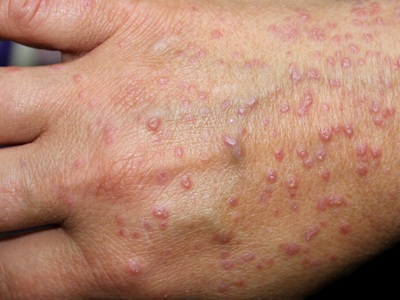Lichen Planus
Lichen Planus: Symptoms, Causes, and Treatment
Lichen planus is an inflammatory condition that can affect the skin, hair, nails, and mucous membranes. It typically appears as itchy, purplish-red bumps on the skin or whitish streaks on mucosal surfaces. Thought to be related to an autoimmune response, lichen planus is not contagious and often follows a chronic course.
Symptoms of Lichen Planus
The symptoms of lichen planus vary depending on the affected area. Common symptoms include:
-
Itchy Skin Lesions
- Purplish-red, raised bumps often appear on the wrists, elbows, lower back, and legs.
- These lesions can be symmetrical and are usually accompanied by itching.
-
White Streaks in the Mouth (Wickham Striae)
- Whitish, lace-like streaks may form on the inner cheeks, gums, or tongue.
- These lesions can cause discomfort or pain, especially when eating spicy or acidic foods.
-
Changes in Hair and Nails
- Hair loss (lichen planopilaris) and thinning, splitting, or loss of nails can occur.
-
Genital and Anal Lesions
- Lesions in these areas may cause itching, pain, or discomfort during sexual activity.
Causes of Lichen Planus
The exact cause of lichen planus is unknown, but it is believed to involve an overactive immune response. The immune system mistakenly attacks healthy skin and mucosal cells. Possible triggers include:
- Stress and Emotional Factors
- Certain Medications: Blood pressure drugs, NSAIDs, or antimalarial medications.
- Hepatitis C Infection
- Genetic Predisposition
- Allergic or Immune Reactions
How is Lichen Planus Diagnosed?
Lichen planus is typically diagnosed through a clinical examination and medical history. In some cases, additional tests may be required:
- Skin Biopsy: A sample of skin tissue is examined under a microscope to confirm the diagnosis.
- Blood Tests: To rule out underlying conditions such as hepatitis C.
Treatment for Lichen Planus
Treatment focuses on managing symptoms and reducing inflammation. Options include:
-
Corticosteroids
- Used topically, orally, or through injections to reduce inflammation and itching.
-
Antihistamines
- Help alleviate itching and improve comfort.
-
Immunosuppressive Medications
- Prescribed for severe cases to reduce the immune system's activity.
-
Phototherapy
- Ultraviolet B (UVB) or PUVA therapy can help reduce skin symptoms.
-
Specialized Treatments for Oral Lesions
- Topical anesthetics for pain relief.
- Antimicrobial mouth rinses to prevent infection.
Home Care and Lifestyle Tips
To manage lichen planus symptoms and improve comfort:
- Keep Skin Moisturized: Use hypoallergenic moisturizers to protect the skin barrier.
- Use Anti-Itch Products: Cooling lotions or anti-itch creams can provide relief.
- Manage Stress: Techniques such as meditation or yoga may help reduce symptoms.
- Avoid Irritants: Steer clear of soaps, alcohol-based products, and harsh chemicals.
Is Lichen Planus Contagious?
No, lichen planus is not contagious. It cannot be spread from person to person through physical contact.
Conclusion
Lichen planus is a manageable condition with proper treatment and care. If you are experiencing symptoms, seeking a diagnosis and treatment plan from a dermatologist is crucial.
Contact our clinic for professional advice and effective treatment to restore your skin's health!





